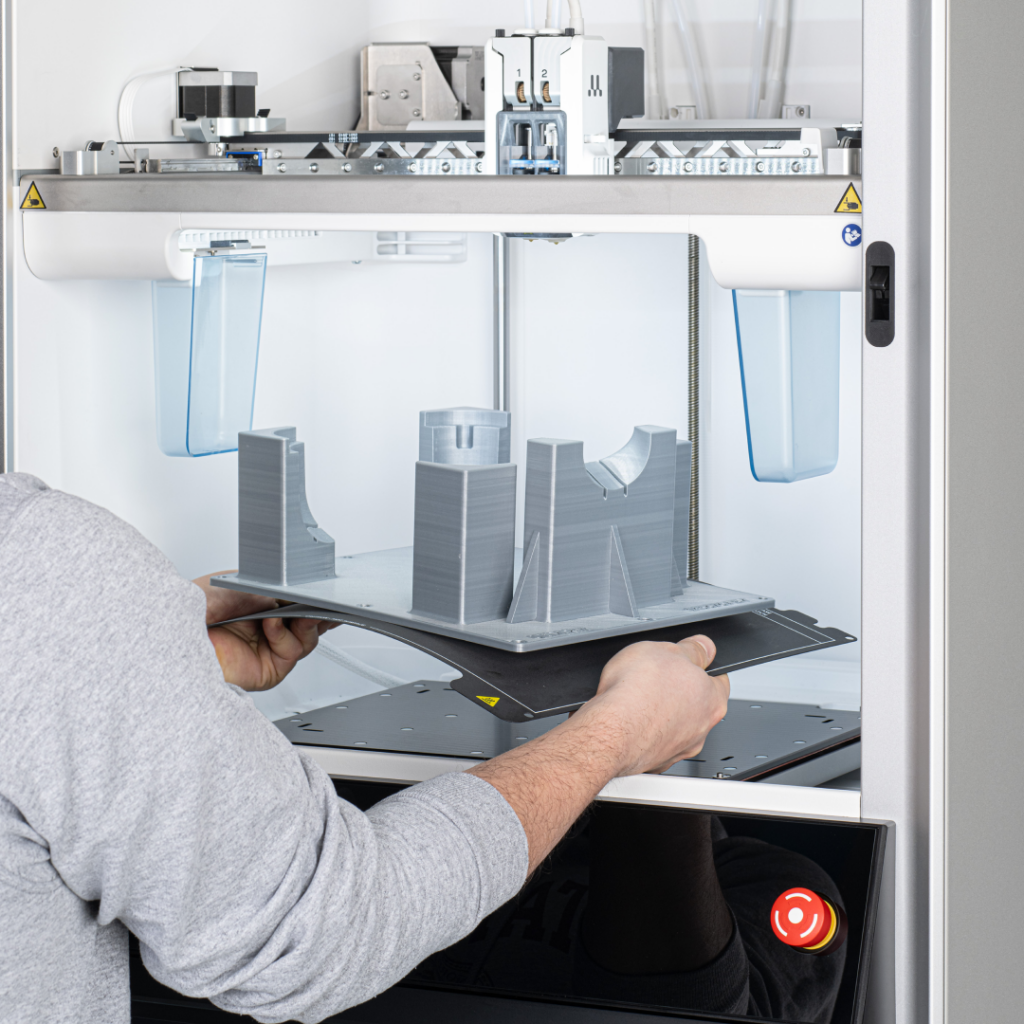UltiMaker has announced its newest industrial 3D printer: The Factor 4. Unveiled officially at the HANNOVER MESSE trade show today, the Factor 4 is being positioned as a new flagship solution for light industrial applications. “There is untapped potential in the light industrial market, and we believe that Factor 4 will enable customers to further explore the application possibilities in this space,” said Ultimaker CEO Michiel Alting von Geusau.
Designed with an eye towards fulfilling the most pressing needs of UltiMaker’s customer base, the Factor 4 was engineered to support industrial users printing process-critical components and fixtures to keep their production lines flowing smoothly.
The Look
The Guts
Looking to expand the capability of end-users, the Factor 4 features an evolution of Ultimaker’s print core technology that facilitates printing up to 340°C. 60° hotter than the S7, this greatly expands the number of materials available to Factor 4 users.
“The quality control and additional sensor technology meet rigorous industry standards. Factor 4 enhances our possibilities for new applications with the widest range of high-performance materials,” said Johannes Karl, Head of Customer 3D Solutions at Krones.
An enhanced suite of on-board sensors provides real-time print monitoring and data collection. The Factor 4 generates a report after every print, allowing the unit to be seamlessly folded into workflows as a tool for ensuring part quality and consistency.

In order to enable quick service to customers and minimal downside to their production lines, Ultimaker’s engineers also designed the Factor 4 to be easy to repair. Modularity was a key design feature. Almost all of the unit’s internal components are easy to access underneath its rear panel. Replacement components will be available as “modules” that can be quickly shipped worldwide.

Additionally, it includes a HEPA filter, essential for processing fumes and particles in material extrusion 3D printing, as well as a low-moisture material handling system which supports up to six spools of filament, keeping them in optimal condition with humidity levels maintained below 15%.
A New Material for Industry
While the Factor 4 will arrive on the market sporting compatibility with one of the largest materials portfolios available, its release is also paired with a brand new material developed by Ultimaker: PPS CF. Polyphenylene Sulfide Carbon Fiber was engineered to produce cost effective replacements to metallic and PEEK parts. Boasting a flame and heat retardant composition, along with chemical resistance, PPS CF is geared towards prototyping and tooling applications in automotive, railway and aerospace industries.
The Market
PEEK, PEKK, and PEI (ULTEM), are key for 3D printing critical parts for the aerospace, defense, oil and gas, and, in some cases, medical sectors. Worth noting is that this system only reaches a build temperature of 70°, below the glass transition temperature of these materials, so it is not quite in line with Stratasys’s industrial material extrusion machines. Stratasys has been facing heavy competition from other high temp material extrusion machines like Roboze, AON3D, 3DGence, INTAMSYS, 3DXTECH, and others. So, this is the first printer that shows much of an attempt by Stratasys, which owns 45.6% of UltiMaker, to take on those foes with a lower cost, high temperature machine.

Additionally, Ultimaker (pre-merger) has always been a go-to brand for prototyping, jigs, fixtures, and other non-critical parts for major manufacturers, such as Volkswagen. However, the company’s development has generally lagged behind competitors. So, while Ultimaker could almost always deliver very well-made, easy-to-use machines, other firms came out with new products at a much faster rate. The Factor 4 is essentially an attempt to revitalize the company’s product line, with MakerBot printers now dedicated to the educational market and Ultimaker now firmly dedicated to engineering and production. In other words, rather than take on Bambu Lab with its speed and price, UltiMaker is continuing to focus up-market. There’s still the possibility that a Bambu-style machine will be released, but for now, UltiMaker is still facing higher-end competitors.
Subscribe to Our Email Newsletter
Stay up-to-date on all the latest news from the 3D printing industry and receive information and offers from third party vendors.
You May Also Like
Hyliion CEO Thomas Healy on 3D Printing’s Role in the KARNO Generator
While the electric vehicle (EV) market faces an uncertain future, there’s no uncertainty about the fact that greenhouse gas emissions are drastically changing the climate on Earth. Thanks to its...
Attending the ASTM F42/ISO TC 261 Meetings: The Nitty-Gritty of Additive Manufacturing
I never thought I’d be so excited about an event focused on additive manufacturing (AM) standards, but here we are! When I learned that the recent biannual ASTM F42/ISO TC...
World’s Largest Polymer 3D Printer Unveiled by UMaine: Houses, Tools, Boats to Come
The University of Maine has once again broken its own record by unveiling the largest polymer 3D printer in the world. Surpassing its 2019 achievement, the new Factory of the...
Gorilla Sports GE’s First 3D Printed Titanium Cast
How do you help a gorilla with a broken arm? Sounds like the start of a bad joke a zookeeper might tell, but it’s an actual dilemma recently faced by...































